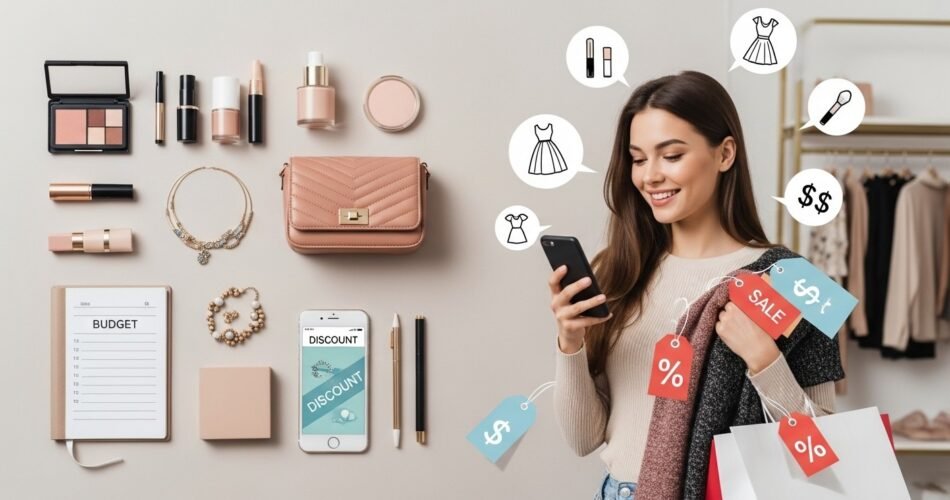It’s a common misconception that looking stylish requires an endless budget. In reality, smart savers know that style is less about how much you spend and more about where and how you spend it. The secret lies in making intentional decisions choosing quality over quantity, knowing when to invest, and learning where you can easily save without anyone noticing.
The fashion and beauty industries thrive on trends that change faster than the seasons. But beneath the noise lies a truth: real style is timeless. In this guide, you’ll learn how to cut costs on beauty and fashion without giving up the polished, confident image you love. From capsule wardrobes and thrifting tricks to affordable skincare swaps and product maintenance, this is your step-by-step manual for staying chic without overspending.
The ValueFirst Mindset
Every smart saver begins with one important shift the mindset. Instead of asking, “Can I afford this?” ask, “Is this item truly worth it?” The difference between a spender and a saver often lies in how they define value. A cheap item that breaks or fades after two uses isn’t a bargain; it’s a loss. Meanwhile, a slightly pricier piece that lasts for years can actually be the most affordable choice in the long run.
Think in terms of cost-per-wear rather than total price. For instance, a $60 blazer that you wear sixty times costs only $1 per wear, while a $20 top worn twice costs $10 per wear. The same rule applies to beauty a $15 moisturizer that lasts three months is more cost effective than a $40 serum you use twice and abandon. The goal is to focus on versatility, durability, and quality.
Another secret of smart savers is delaying gratification. Before buying something, add it to a “wishlist” for at least a week. Many people find that after a few days, the impulse fades. This method alone can save hundreds each year.
Building a Smarter Wardrobe
Creating a capsule wardrobe is one of the most powerful ways to reduce costs while keeping your look cohesive and stylish. A capsule wardrobe focuses on essential, high quality pieces that can be mixed and matched to create dozens of outfits. Instead of overflowing closets filled with clothes you barely wear, you’ll have a curated selection of items that always look put together.
Start with neutral basics like a white tee, black trousers, fitted jeans, and a well tailored blazer. Choose a few accent colors that flatter your complexion, and make sure everything coordinates easily. This way, you can create variety without constant new purchases. When you buy a piece, make sure it fits perfectly or can be tailored affordably. A $10 tailoring adjustment can make an inexpensive thrift find look custom made.
You don’t need to buy everything new. Many smart dressers begin with thrifted or secondhand basics and gradually upgrade them over time. Shopping off season can also lead to huge savings winter coats are often 60% cheaper in spring, and swimwear can drop drastically in autumn. The key is patience and planning.
Shopping Smarter When and Where to Buy
Not all shopping experiences are created equal. Learning where and when to buy can make a huge difference in your yearly expenses. Thrift stores and consignment shops are treasure troves for stylish finds, especially if you know what to look for. Focus on fabric quality and condition instead of brand names. A well-made cotton blouse or wool coat can last far longer than a trendy piece from a fast-fashion chain.
Outlet stores, factory shops, and flash sale websites are also gold mines for budgetconscious shoppers. They often carry last season’s items at half the price. However, make sure you buy only what fits your wardrobe vision. The thrill of a discount can easily lead to unnecessary purchases.
Timing is another powerful savings tool. Retailers follow predictable sales cycles. For example, the best time to buy boots is right after winter ends, and summer dresses drop in price by late August. Use browser extensions that track price history and apply coupons automatically. Set price drop alerts for wishlist items and wait for the right moment to buy patience here often pays with 20 40% discounts.
Simplifying Beauty Without Losing Results
When it comes to beauty, more products rarely mean better results. The key to cutting costs is simplifying your routine to focus on what truly works. The foundation of effective skincare is simple: cleanser, moisturizer, sunscreen, and one active product like a serum or exfoliant. Once these essentials are in place, everything else becomes optional.
Multi-use products are a saver’s secret weapon. A tinted moisturizer with SPF replaces foundation and sunscreen in one step. A cream blush can double as a lip tint, and a neutral eyeshadow shade can also serve as a highlighter. By choosing versatile products, you reduce clutter and save money while maintaining a polished look.
Knowing where to spend and where to save is another important skill. Spend wisely on skincare items where ingredients truly matter, such as sunscreen or active serums. Save on color cosmetics and trend-based products that frequently change. Drugstore brands have improved dramatically in recent years, often performing just as well as luxury counterparts.
DIY beauty can also play a role if done safely. Simple recipes like a sugar and oil scrub or a coconut oil hair mask offer affordable pampering without expensive salon treatments. Always patch test new ingredients and prepare small batches to avoid waste.
Caring for What You Already Own
Maintenance is the most overlooked part of saving money in both fashion and beauty. The longer your items last, the less you need to replace them. Taking care of your wardrobe and beauty tools can save hundreds each year.
Learn the basics of garment care wash clothes less frequently to preserve fabric, follow care labels, and air items between wears. Keep a small sewing kit on hand to mend loose buttons or small tears immediately. For knitwear, a fabric shaver can restore a like new look. Shoes benefit from occasional polishing and proper storage, especially when paired with inexpensive shoe trees that maintain shape.
Beauty products also require thoughtful care. Store them in cool, dry spaces away from sunlight to extend shelf life. Clean makeup brushes regularly to avoid product buildup and skin issues. Use sanitary practices such as spatulas instead of fingers to reduce contamination. These small habits stretch the life of your purchases and protect your skin.
Trading, Swapping, and Learning
Style doesn’t have to be solitary or expensive. Smart savers often build small communities where they exchange clothes, share tips, and even trade beauty products (safely). Organizing a clothing swap among friends is not only fun but a zero-cost way to refresh your wardrobe. You can donate items you no longer love and take home something that feels new.
Similarly, local repair workshops and sewing cafes often host free or affordable sessions where you can learn simple mending skills. A small hem, a button replacement, or a patch repair can revive a piece that would otherwise be discarded. Over time, these small acts save you from frequent repurchases and build a deeper appreciation for what you own.
Developing a few practical skills pays off long term. Knowing how to clean stains properly, polish shoes, or perform minor repairs allows you to extend the lifespan of your favorite pieces and maintain your personal style affordably.
Budget Planning and Monthly Style Routine
Even the most stylish budgeter needs structure. Setting a small, consistent “style fund” each month keeps your spending under control while giving you freedom to invest intentionally. For example, with a $100 monthly style budget, you might allocate $40 toward a long-term investment piece like a coat, $30 toward essentials such as sunscreen or deodorant, $20 toward thrift finds or tailoring, and $10 reserved for repairs or adjustments.
To stay on track, review your purchases monthly. Remove impulse items that didn’t add value and adjust your plan accordingly. Clean out one section of your closet to identify unworn pieces you can sell or swap. The money you recover can fund future purchases or savings.
Creating this habit ensures that every dollar spent on beauty or fashion brings real satisfaction. Over time, you’ll notice that your wardrobe feels fuller, your vanity less cluttered, and your wallet far healthier.
Affordable Swaps That Keep Style Intact
One of the easiest ways to maintain your look while saving money is to replace expensive habits with smarter alternatives. For instance, instead of buying full size high end foundation, switch to a tinted moisturizer with SPF you’ll get the same glow with added skin protection. Replace pricey salon hair masks with a simple homemade coconut oil treatment to save $20 $30 a month.
When it comes to clothing, opt for one neutral, high-quality coat instead of several trendy ones that fall apart after one season. Learn to polish and resole shoes instead of replacing them. A good repair can extend shoe life by years and cost a fraction of a new pair.
Accessories can also drain budgets quickly. Rather than buying multiple seasonal accessories, invest in timeless scarves and belts that can be styled differently across outfits. These subtle shifts don’t reduce your options they simply make your style smarter and more sustainable.
Examples of Smart Style in Action
Imagine starting your day with a capsule wardrobe. You pull on a pair of well fitted jeans, a crisp white tee, and your thrifted black blazer. Add a vintage belt and a patterned scarf, and you’ve created a chic outfit in under five minutes all built from versatile, affordable pieces.
In beauty, the same principle applies. Your morning routine could be as simple as applying tinted moisturizer with SPF, a quick dab of cream blush that doubles as lipstick, a brush through your brows, and a coat of mascara. You’ll look fresh and polished in minutes without needing an overflowing vanity.
For skincare, less truly is more. A gentle cleanser, a moisturizer rich in ceramides, and a quality sunscreen make a perfect foundation. Adding one weekly treatment such as a mild exfoliant or serum is enough to maintain a healthy glow without overspending on dozens of bottles.
Optimized for Featured Snippets
How can I cut beauty costs without losing quality?
You can cut beauty costs by prioritizing essentials, using multi purpose products, and choosing effective but affordable brands. Focus your spending on sunscreen and key skincare ingredients, and skip overpriced packaging or fleeting trends.
Is thrifting a good way to stay fashionable?
Absolutely. Thrifting allows you to find high quality, unique pieces at a fraction of the price. Look for natural fabrics and classic cuts that can be styled multiple ways. A quick tailoring session can make even secondhand clothes look designer quality.
What are the best affordable beauty products?
Drugstore staples like tinted moisturizers, gentle cleansers, and cream blushes are excellent choices. They offer performance comparable to luxury brands when chosen wisely. Always read ingredient lists and reviews before buying.
How long do beauty products last?
Mascara should be replaced every three months, while foundations and creams last six to twelve months. Powders can last up to two years if stored properly. Always check smell and texture before using.
Are DIY beauty treatments safe?
Some are, if kept simple and used immediately. Recipes like sugar scrubs or oil based hair masks are generally safe when made fresh and patch tested. Avoid long term storage or untested ingredients.
Final Style and Savings Checklist
Make saving and styling part of your routine. Each day, aim to use fewer, more versatile products. Each week, inspect your clothes for small repairs and plan one outfit around a favorite piece. Every month, review your spending, declutter one section of your wardrobe, and identify an investment piece you’d like to save toward. These tiny, consistent actions build a strong foundation of sustainable style.
Remember, being stylish isn’t about chasing trends or spending the most money. It’s about understanding your personal taste, maintaining what you own, and spending thoughtfully. You don’t need to follow every fashion update or buy every new beauty launch. Instead, cultivate confidence in the pieces and products you already have.
When you start viewing your wardrobe and routine as long term investments rather than short-term thrills, your financial life and your personal style both improve dramatically.
Conclusion Confidence Over Consumption
The truth is, elegance doesn’t come from excess it comes from intention. Cutting costs on beauty and fashion doesn’t mean settling for less. It means choosing smarter, buying fewer but better, and valuing your own creativity over marketing trends. When you curate instead of collect, repair instead of replace, and invest instead of impulse-buy, your savings grow, your wardrobe lasts, and your style becomes uniquely yours.
So next time you’re tempted by a sale or a viral beauty product, pause and ask: does this align with my long term style and values? If the answer is no, save your money for something that truly does. That’s the essence of being a smart saver confident, stylish, and financially free.



